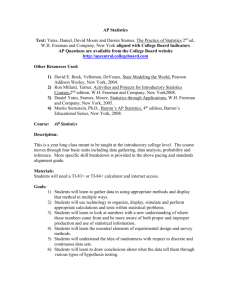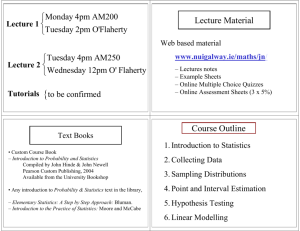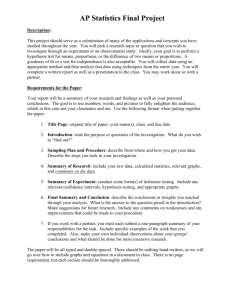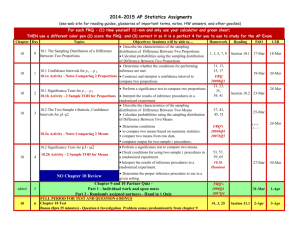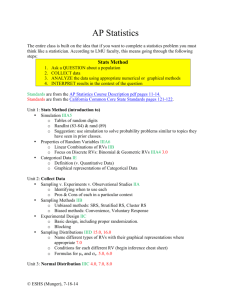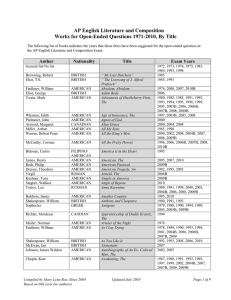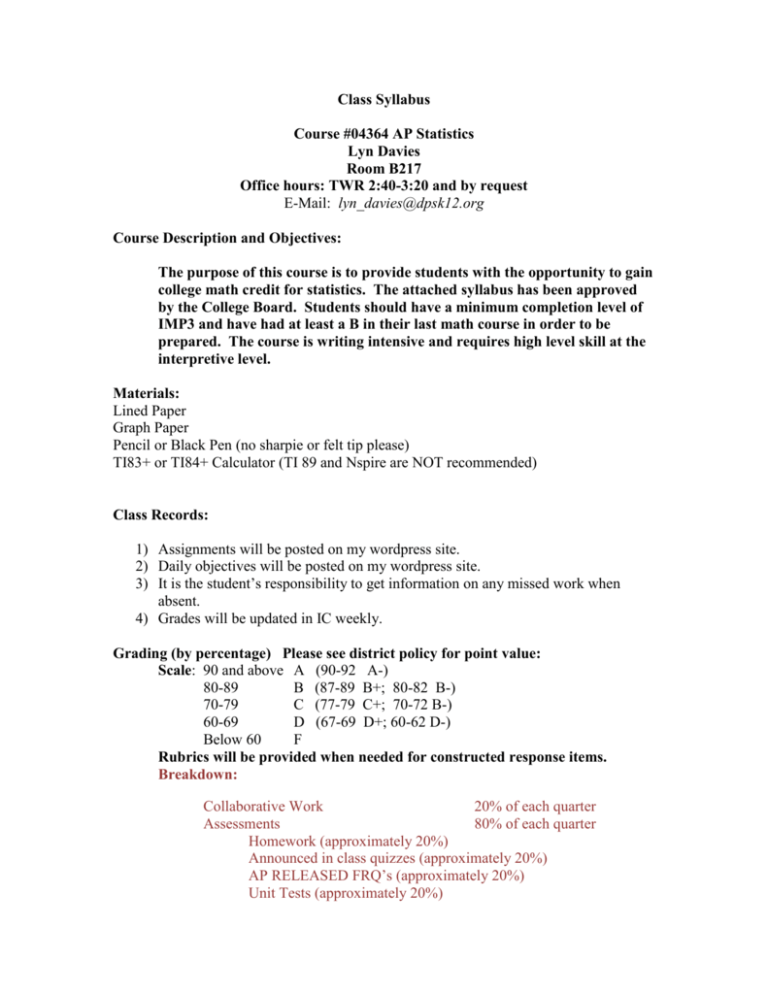
Class Syllabus
Course #04364 AP Statistics
Lyn Davies
Room B217
Office hours: TWR 2:40-3:20 and by request
E-Mail: lyn_davies@dpsk12.org
Course Description and Objectives:
The purpose of this course is to provide students with the opportunity to gain
college math credit for statistics. The attached syllabus has been approved
by the College Board. Students should have a minimum completion level of
IMP3 and have had at least a B in their last math course in order to be
prepared. The course is writing intensive and requires high level skill at the
interpretive level.
Materials:
Lined Paper
Graph Paper
Pencil or Black Pen (no sharpie or felt tip please)
TI83+ or TI84+ Calculator (TI 89 and Nspire are NOT recommended)
Class Records:
1) Assignments will be posted on my wordpress site.
2) Daily objectives will be posted on my wordpress site.
3) It is the student’s responsibility to get information on any missed work when
absent.
4) Grades will be updated in IC weekly.
Grading (by percentage) Please see district policy for point value:
Scale: 90 and above A (90-92 A-)
80-89
B (87-89 B+; 80-82 B-)
70-79
C (77-79 C+; 70-72 B-)
60-69
D (67-69 D+; 60-62 D-)
Below 60
F
Rubrics will be provided when needed for constructed response items.
Breakdown:
Collaborative Work
20% of each quarter
Assessments
80% of each quarter
Homework (approximately 20%)
Announced in class quizzes (approximately 20%)
AP RELEASED FRQ’s (approximately 20%)
Unit Tests (approximately 20%)
Final Exam
10% of the final grade
Reference:
Collaborative Work: Any work that involves collaboration either inside or
outside of class.
Each team write up must contain clear reference to
every individual in the team that identifies his/her
contribution. Expectations for write ups will be made
clear in writing and verbally for each assignment.
All members of the team must participate in
presentations.
Homework: Homework that is collected will be graded for accuracy using
the AP rubric for free response problems where applicable.
At the end of each quarter, the lowest two homework
scores will be dropped.
In Class Quizzes: Quizzes given during a unit on which a student may
references his/her notes.
Some quizzes will be open note-no shared or smart
notes allowed.
AP RELEASED FRQ (Free Response Question): Instructions will be
given as to whether a given question is to be submitted in class or
electronically submitted.
Each section will be scored E (essentially correct), P
(Partially correct) or I (Incorrect) as described by the
College Board. General guidelines are listed below.
More specific rubrics will be available when needed for
individual AP RELEASED FRQ’s
Identical papers or portions of papers between two or
more students may be subject to questions regarding
academic misconduct.
Unit Test: Closed note, in class tests.
Individual free response questions will be scored using
the E, P, I designations which will be translated to a 0-4
score for the problem.
Multiple choice problems may be weighted according
to level of difficulty. Such weight will be designated on
the test.
A test grade will be assigned based on the sum of all
possible points on the test.
E, P and I designations:
E: Essentially Correct indicates that minor errors may exist, but a
correct understanding of the problem is clearly present.
P: Partially Correct indicates that the student has demonstrated some
understanding of the problem, but needs some follow up instruction.
I: Incorrect indicates the student has little or no understanding of the
concepts embedded in the problem. A great deal of follow up instruction is
needed.
In Class Procedures:
1) Please have caps on liquids and use good judgment on snacks brought to class.
2) Cell phones should be kept in the vibrate position and concealed.
3) Minor discipline problems including excessive tardies, class disruptions and off
task behavior that interferes with the offender’s learning will be handled on a case
by case basis in the following manner:
a. (1st offense) Talk to the student(s) involved.
b. (2nd -3rd offense) E-mail to the parent
c. Repeated offenses may be handled with referral and/or parent conference.
d. A student who is habitually absent/tardy or a discipline problem will be
denied my outside tutoring services pending a parent conference.
4) Severe discipline problems such as bullying, extreme disruption and/or behavior
that interfere with the learning process for more than just the offender will be
dealt with immediately by referral and possible removal from class via short term
suspension if necessary in accordance with DPS tiered discipline ladder.
5) Late work will be accepted in accordance with DPS grading policy.
a. Students have two school days per excused absence to hand in late work.
b. Work that is turned in late without prior extension or absence will be
penalized in the following way:
i. 20% penalty for 1-2 days late
ii. 50% penalty for 3+ days late until the unit assessment
iii. No late work will be accepted for the unit after the assessment has
been given.
Attendance:
If a student is tardy unexcused after AP RELEASED FRQ or homework
collection, the assignment will be given a maximum of 80% credit after accuracy
grading.
If a student is tardy unexcused on an assessment day, no extended time will
be given.
If a student is absent, it is his/her responsibility to see me or contact me for notes.
Notes will be available from class electronically.
Electronic and/or face to face parent conferencing will be used to alleviate
habitual attendance problems.
I do offer outside tutoring by appointment for students who have given every
effort in class, maintained good attendance and need supplemental instruction. Tutoring
is in no way a substitute for attending class. Students with three or more unexcused
tardies, and/or two or more unexcused absences will be denied my outside tutoring
services. Students with severe numbers of excused absences and tardies may also be
denied tutoring from me pending parent conferencing.
Electronic or hard copy acknowledgement of having read this syllabus serves as a
contract between myself the student and parents. Please acknowledge by 09.01.11.
AP Statistics
Text: Yates, Daniel, David Moore and Darren Starnes, The Practice of Statistics, 4e.,
W.H. Freeman and Company, New York,. 2011. Aligned with College Board Indicators
Optional purchase site:
http://www.amazon.com/s?ie=UTF8&rh=n%3A2205237011%2Ck%3A142924559X&pa
ge=1
eText
ISBN-10 142927185X; ISBN-13 9781429271851
Print
ISBN-10 142924559X; ISBN-13 9781429245593
AP released questions are available from the College Board website
http://apcentral.collegeboard.com
Other Resources Used:
1) David E. Bock, Velleman, DeVeaux, Stats Modeling the World, Pearson
Addison Wesley, New York, 2004.
2) Ron Millard, Turner, Activities and Projects for Introductory Statistics
Courses,2nd edition, W.H. Freeman and Company, New York2008.
3) Martin Sternstein, Ph.D., Barron’s AP Statistics, 4th edition, Barron’s
Educational Series, New York, 2008.
Course: AP Statistics
Description:
This is a year long class meant to be taught at the introductory college level. The course
moves through four basic units including data gathering, data analysis, probability and
inference. More specific skill breakdown is provided in the above pacing and standards
alignment guide.
Materials:
Students will need a TI-83+ or TI-84+ calculator and internet access.
Goals:
1) Students will learn to gather data in using appropriate methods and display
that method in multiple ways.
2) Students will use technology to organize, display, simulate and perform
appropriate calculations and tests within statistical problems.
3) Students will learn to look at numbers with a new understanding of where
those numbers came from and be more aware of both proper and improper
production and use of statistical information.
4) Students will learn the essential elements of experimental design and survey
methods.
5) Students will understand the idea of randomness with respect to discrete and
continuous data sets.
6) Students will learn to draw conclusions about what the data tell them through
various types of hypothesis testing.
College Board/
Text Section
Days
Resources
Indicator Ref. #
(Time) AP Questions;
Block Vocabulary
1.0 Exploring Data
Objectives: 1) Students will
15
become familiar with all major
types of data display including
bar charts, pie charts, dot plots,
line plots, stem and leaf plot,
boxplots and histograms.
2) Students will be able to
construct data displays
for quantitative variables
and will use TI-84
calculators to construct
histograms, boxplots and
scatter plots.
3) Students will be able to
choose and justify
appropriate summary
statistics for a data set
after commenting on the
shape, center and spread
of a distribution based
on the raw data and its
display.
4) Characteristics of
density curves with an
emphasis on Normal
Distributions will be
explored including
standardizing data and
the empirical rule.
5) Students will use normal
probability plots to help
justify the use of a
normal model.
6) Students will assess
linearity of bivariate
data by looking at a
scatter plot, residual plot
and calculating the
correlation coefficient.
7) Students will use
technology to generate
models for data
including LSRL and
comment on those
models using the
coefficient of
In addition to the
text demonstrations
will be made using
Fathom software in
class.
Essential
Vocabulary:
Individuals
Variable
(categorical and
quantitative)
Distribution
Shape
Center
Spread
Outlier (know all
types and how to
test for them)
5 number summary
Mean
Standard deviation
Normal curve
LSRL
Residual
Correlation
Influential point
Conditional
Distribution
Simpsons’s paradox
determination and other
analysis.
8) Students will use models
to make predictions
about the data.
9) Students will use basic
functions to transform
data in order to improve
analytical potential.
1.1 a, b, c, d
1.2 a, b, c, d, e
Introduction pp. 7-26
Displaying data-charts
pp. 27-50
dotplots/stemplots/histograms
pp. 51-81
mean/5 number summary
QUIZ #1-Passing Grade
Required. Retake until pass.
1.3 a, b, c, d
3.3 a, b, c
1.4 a, b, c
2 after school review sessions
will be offered. (required for
those who fail the quiz)
pp. 84-109
Describing Location in a
Distribution
Percentiles, z-scores,
cumulative frequency graphs,
data transformation, mean,
median, standard deviation
pp. 110-139
density curves-normal dist.
68-95-99.7 Rule
Standard normal distribution
Normal probability plot
Chapter 2 Test
pp. 141-157
Bivariate Data (Describing
Relationships)
scatterplots-basics
0
.5
(45)
.5
(45)
.5
(45)
2.5
(225)
4
(360)
1
(90)
1.5
(135)
AP: 2001 #6a;
2002B #5; 2003
#1a,b; 2006 #1;
2008B #1
AP: 2005 #1a
(choice of measure
of center)
AP: 2000 #3; 2001
#1; 2004B #5a; 2004
#1; 2006 #1
AP: 2007 #1a
1998 #6a; 1999
#4a,c; 2002 #3a;
2004B #3a,b
2.0 Sampling and
Experimentation
2.1 a, b, c, d
2.2 a, b, c, d
pp. 164-197
LSRL, standard equation,
4
extrapolation, residuals, residual (360)
plot, standard deviation of
residuals, coef. of determination,
influential observations,
association v. cause
1
Chapter 3 Test
(90)
Chapter 4
Objectives: 1) Students will
7
understand how to gather data
effectively by asking the key
question: What do we want to
discover?
2) Students will learn to
construct appropriate
survey questions to
answer questions about
a target population.
3) Students will learn to
model situations through
simulation techniques
using TI-84 calculators
and Fathom software.
4) Students will understand
the difference between
observational studies
and experiments.
5) Students will learn how
to determine the effects
of treatments on a
response variable
through experimental
design.
AP: 1998 #2; 2000
#1; 2002B #1
pp. 206-230
observation v. experiment
population, sample, sample
AP: 2005 #5b,c;
2007 #5a
HW 11: p.285-289
2
(180)
Essential
Vocabulary:
Observational Study
Experiment
Population
Sample
Sampling
Census
Voluntary Response
Sample
Biased
SRS
Probability Sample
Stratified Random
Sample
Undercoverage
Nonresponse
Systematic Random
Sample
Convenience
Sample
Factor
Level
Placebo
Randomize
Control
Replicate
Block
Blinding (double)
Probability Model
Simulation
2.3 a, b, c, d, e
3.1 e, 2.4
survey, random sampling, SRS,
random digits, stratification,
strata, cluster sample, bias,
voluntary response, convenience,
sampling errors, undercoverage,
sampling frame, non sampling
errors, non response, response
bias.
pp. 231-261
designing experiments:
Units, subjects, treatments,
3.5
explanatory, response,
(360)
confounding, lurking, factors,
levels, placebo, controls,
randomization, replication,
significance, single v. double
blind, blocks, matched pairs
AP: 2003B #3a;
2007 #2
1998 #3; 1999 #3;
2000 #5; 2001 #4
(blocking); 2002 #2
(match pairs
design); 2002B #3;
2003 #4
(randomization);
2004 #2 (blocking);
2004B #2; 2006 #5
2003 #4a,b,d; 2007
#2b
pp. 261-276 Using studies wisely
Test Chapter 4
3.0 Anticipating
Patterns
all
Objectives: 1) Students will
explore random behavior and
become familiar with the Law of
Large Numbers.
2) Students will learn basic
probability rules through
simulation and formal
methods.
3) Students will move from
discrete probability
calculation to theoretical
distribution models
including the normal
model, geometric model
and binomial model.
.5
(90)
1
(90)
24
Essential
Vocabulary:
General Probability
Rules
Disjoint
Complimentary
Independent
Event
Outcome
Without
replacement
Discrete
Continuous
Expected Value
Binomial
Probability
Geometric
Probability
3.1 a
pp. 280-293
Law of large numbers,
probability, simulation
State/Plan/Do/Conclude
1
(90)
3.1 c
pp. 299-312
sample space, event, probability
model, mutual exclusivity
(disjoint), Venn diagrams, 2 way
tables, general addition rule
pp. 312-333
Conditional Probability
Independence, tree diagrams,
general multiplication formula,
conditional probability formula
pp. 340-357
discrete/continuous random
variables, normal distributions
as PRB distributions, expected
value (mean), variance of a
random variable
1.5
(135)
3.1 c
3.1 d
3.1 b, f
3.1 d
2.5
(225)
pp. 358-376
Linear Transformation of a
random variable
2.5
(225)
pp.382-408
binomial and geometric
distributions
4.5
(395)
Chapters 5 & 6 Test
2.2 a, b, c
2
(180)
pp. 412-432
sampling distributions,
parameter, statistic, population
distribution, unbiased estimator,
biased estimator, variability of a
1
(90)
3
(270)
AP: 1997 #3; 1999
#5; 2003B #2; 2004
#4a
AP: 1999 #5b;
2000 #6b,c; 2001
#2; 2002 #3; 2002B
#2; 2003B #5; 2003
#6a; 2004B #3c,d
(normal curve);
2004 #4b,c; 2005 #2
(expected values);
2006 #3a
AP: 1998 #6b,c,d,e;
1999 #4b; 2001 #3;
2004 #3 (conditions
for binomial
setting); 2006 #3b,c
3.4 a
3.4 b, c
4.0 Statistical
Inference
4.1 c, f
statistic
pp. 432-441
sample proportions, p hat v. p,
pp. 442sample means, central limit
theorem(CLT), sampling
distribution of x bar
Chapter 7 Test
2
(180)
3
(270)
AP: 1998 #1
(CLT); 2004 #3c,d
(CLT); 2007 #3
1
(90)
*****Semester 1 Final******
Objectives: 1) Students will use 39
sample statistics to estimate a
range of possible values for
population parameters
(confidence intervals).
2) Students will propose
models for situations
and examine observed
statistics to see if the
model makes sense.
3) Students will learn to
appropriately identify
and use inference
procedures to test
hypothesis based on the
central limit theorem
including tests about
proportions and means.
4) Students will learn to
check underlying
assumptions for all tests.
5) Students will know when
to use t models,
matched-pairs t models
and how to perform tests
on counted data.
6) Students will identify
understand and perform
inferences for
regression.
pp. 466-484 estimating with
confidence, confidence intervals 3
for a population mean, margin of (270)
error, point estimator, point
estimate, confidence level
Essential
Vocabulary:
Hypothesis
Null
Type I Error
Type II Error
Power
Significance Level
Standard Error
Pooled Data
Confidence Level
Inference
Margin of Error
P-Value
AP: 2007 #1c
4.2 a, d
4.2a
pp. 484-498
standard error, conditions for
confidence for proportions
(Random, Nearly Normal,
Independence or 10%)
pp. 499-522
estimating a population mean,
standard error formula, df, one
sample t, conditions, robustness
Test Chapter 8
3.4 g, 4.1 f, 4.2 a, d
2
(180)
4
(360)
1
(90)
pp. 526 – 549
Significance test, null hypothesis, 4
alternative hypothesis, one sided, (360)
two sided, P-value, significance
level, reject v. fail to reject.
4.1 g, 4.2 e
Inference as decision, type I and
type II errors, power
pp. 549-587
one sample z, one sample t,
conditions, paired data
Test Chapter 9
4.1 d, 4.2 b
4.1 e, 4.2 c
AP: 2002 #1; 2002
#6a,b; 2003B #6;
2003 #6b,c,d
5
(450)
AP: 2000 #2 (ttest); 2003 #1c;
2004 #6 (confidence
interval only);
2004B #5b,c; 2007
#4
AP: 1999 #6a,b;
2000 #4; 2001 #5
(paired t-test or two
sample z test);
2002B #6a; 2003B
#4c; 2004B #4
(confidence interval
only); 2005 #6; 2006
#4;1998 #5; 2002B
#4; 2003 32 (Type I
and Type II Error)
1
(90)
pp. 600-626
inference for two populations,
2.5
conditions (normality, random,
(225)
independent samples), 2 sample
z interval for proportions, pooled
proportions tested with 2 sample
z.
pp. 627-660
comparing two means,
3
AP: 2000 #6; 2002
#5, #6c,d; 2003B
3.4 h, 4.2 f
4.2 f
conditions (random samples,
normality, independence of
samples), two sample t interval
for confidence and two sample t
test for significance
(270)
Chapter 10 Test
1
(90)
pp. 674-695
Chi square test for goodness of
fit, observed counts, expected
counts, chi square distribution,
large sample size condition,
components
13.2 pp. 696-731
inference for two-way tables,
chi-square statistic, chi-square
test for homogeneity of
populations, chi-square test of
association/independence
Cumulative Test
4.1 h, 4.2 g
1.4 d,e
1.5 a-d
pp. 738-759
regression inference, confidence
intervals for the regression
slope, conditions (linear
relationship, independence of
observations, normality of
response variable, equal
variances of x and y, random
production of data), t interval for
slope, standard error of slope, t
test for slope
pp. 766-792
transforming relationships
log/ exponential/power models
#3b; 2004B #6;
2007 #5
2
(180)
3
(270)
AP: 1999 #2
(independence);
2002 #6; 2002B #6b
(homogeneity); 2003
#5 (independence);
2003B #5c
(independence);1997
#6; 2004B #1
1
(90)
AP: 2001 #6b
3
(270)
3
(270)

